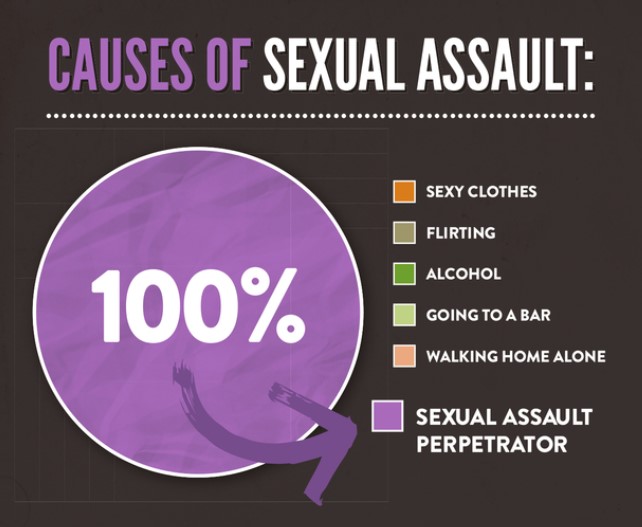UNDERSTANDING MYTHS
A great many false beliefs influence how sexual violence is understood by those who experience it, those who perpetrate it, the families and friends of both survivors and perpetrators, those who respond in professional capacities, and the broader public. Myths and attitudes about sexual violence impact the outcomes of support and legal measures, access to resources and the short and long term consequences experienced by survivors. Myths about sexual violence are rooted in and contribute to the social context in which all forms of sexual violence are perpetuated:
- The seriousness of sexual violence is minimized,
- the meaning of consent is distorted,
- and survivors are reluctant to report, blame themselves for what happened, and worry that they will not be believed.
Survivors of sexual assault (rightly) assume that helpers, also seen in a position of authority, hold the same attitudes that they have already experienced and/or hold themselves. This makes disclosing what has happened to them, very risky. In situations resulting from traumatic events, especially when it relates to sexual violence, anticipated stigma strongly affects whether the survivor discloses at all.
Held beliefs about sexual violence also impact those in a support/intervention role who, despite best efforts, can unintentionally communicate these. Effective responses to disclosures include taking an active role in dispelling false beliefs about sexual violence.
Also, given the frequency of sexual violence in our society, many potential responders have themselves been affected in some way by instances of sexual violence. The impacts of personal experiences for responders are discussed further in the Professional Practice section of the training.

This image by SACHA Sexual Assault Centre in Hamilton addresses myths about sexual assault. Clothing, flirting, alcohol, going to a bar or walking home alone are not the cause of sexual violence.
Rape myth acceptance is associated with stereotypical gender constructs and oppressive beliefs.
Researchers at the University of Toronto conducted a meta-analysis on 37 North American studies (34 from US and 3 from Canada) on rape myth acceptance, (Suarez and Gadalla, 2010). They found myth acceptance was associated with oppressive beliefs such as racism, classism, sexism, heterosexism, ageism, and religious intolerance.
From Overcoming Barriers and Enhancing Supportive Responses
Sexual violence is 100% caused by the sexual assault perpetrator.
Myth Busting
View this Fact Sheet on Sexual Assault Myths
Myths . . . women often provoke sexual assault by their behaviour or manner of dress
Fact: No behaviour or manner of dress justifies an assault. This myth takes the onus off the offender and places it on the survivor. The idea that any survivor of sexual violence “asks for it” is often used by offenders to rationalize their behaviour. Offenders are solely responsible for their own behavior.
Myths . . . most women lie about sexual assault
Fact: The number of false reports for sexual assault is very low, consistent with the number of false reports for other crimes in Canada.
Sexual assault is actually one of the most under-reported crimes. Canadian statistics tells us that victimization surveys show that less than 10% of women who are sexually assaulted report the assault to the police; most survivors do not report due to humiliation or fear of re-victimization in the legal process.
Myths . . . there is no such thing as a male survivor of sexual assault
Fact: Men and boys can be sexually assaulted too. Women and girls are considerably more likely than men to be targeted; however men can be sexually assaulted regardless of size, strength, appearance, sexual orientation or gender expression. Males under 12 years old are particular vulnerable to sexual offences (Statistics Canada, 2006). When men are sexually assaulted or harassed, at any age, they face stigma imposed by patriarchal views about masculinity.
Sexual violence is motivated by power and control.
It is carried out through sexual means or by targeting sexuality.
– Ontario Sexual Violence Action Plan 2011
